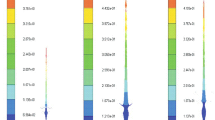Abstract
Shaped charges are very convenient in the formation of very intensive local forces required for penetration and demolition of high strength targets, important in military area. It is generally used to penetrate armored vehicles such as tanks and to demolish concrete fortifications, fuel vessels and bridge constructions, in mining and geophysics, e.g., petroleum research for hard rock penetration and cutting, also in welding and demolition works in industry. In this study, effects of wall thickness variation of the conical copper (CU-OFHC) liner in model group T1 and T2 are investigated. Wall thickness variation is taken into account from the center of the apex to the circular base edge in model group T1 and from the circular base edge to the center of apex in model group T2. In this sense, the relation between the variable thickness, and the geometry and pressure of the jet is investigated. Obtained results are evaluated to determine the stand-off distance between the shaped charge and target which is most important in jet performance. Thickness variation along the liner length changes the liner wall cross-sectional area and increases the liner total mass at both the model groups. Hence, the similar behavior is expected in the two model groups. Hence, the results do not show such a similar behavior between the two model groups. Consequently, It can be said that the dominant parameter is geometrical change, not increase in total mass. This also means that the mass distribution in the liner is determinative parameter in jet formation.

Similar content being viewed by others

References
Walters, W.P.; Zukas, J.A.: Fundamentals of Shaped Charges. New York (1980)
Kelly, R.J.; Curtes, J.P.; Brenner, M.: On analytical modeling of casing and liner thickness variations in a shaped charges. J. Appl. Phy. 75(1), 96–103 (1994)
Walters, W.P.; Summers, R.L.: An analytical expression for the velocity difference between jet particles from a shaped charge. American Institute of Physics. pp. 1861–1864 (1994)
Akcay, M.: Ballistics, Ataturk Univ., Erzurum Turkey (1993) (in Turkish)
Walls J.M., Shrefler R.G., Willing F.J.: Limiting conditions for jet formation in high velocity collisions. J. Appl. Phys. 243(3), 349–359 (1953)
Birkhoff G., Macdougall D.P., Pugh E.M., Taylor S.G.: Explosives with lined cavities. J. Appl. Phys. 19, 563–582 (1948)
Held M.: Phenomenological Description of the function of shaped charge. J. Expl.Propellands 7, 1–7 (1991)
Tonghu, Z.; Hua, T.; Shougi, Z.: Effects of detonation Front Geometry on Jet Performance of Shaped Charges. Effects of detonation Front Geometry on Jet Performance of Shaped Charges, In: 16th International Symposium on Ballistics, Sanfrancisco, CA, USA (1996)
Mayseless, M.; Hirsch, E.; Lindenfeld, A.; Schwartz, A.: Effect of explosive on the shaped-charge jet formation characteristics. Effect of explosive on the shaped-charge jet formation characteristics. In: 16 International Symposium on Ballistics, San-Francisco, CA, USA (1996)
Aksoy, I.G.; Sen, S.: The Effect of Liner Thickness and Explosive Type on Shaped Charge Jet Formation. In: National Defense Industry Symposium, Ankara, Turkey (2002) (in Turkish)
Aksoy I.G., Sen S.: The Effect of conical liner apex angle and explosive ignition point on shaped charge jet formation. Indian J. Eng. Mater. Sci. 10, 381–389 (2003)
Sen, S.; Aksoy, I.G.: The Effect of Conical Liner Thickness Variation on Shaped Charge Jet Formation. In: 13th Conference for Computer Aided Engineering and System Modelling with Exhibition November, Ankara, Turkey (2008)
Harlow, F.H.; Pracht, W.E.: Formation and penetration of high speed collapse jets. Phys. Fluids. 9(10), 1951–1959 (1966)
Thiel M.V., Levatin J.: Jet formation experiments and computations with a Lagrange code. J. Appl. Phys. 51(12), 6107–6114 (1980)
Hirsch, E.; Chou, P.C.; Cicarelli, R.D.: General kinematical solution to the motion of an explosively driven liner. Propel. Exp. Pyrotec. 11(2), 53–64 (1986)
Lee, W.H.: High explosive modeling in 2D Euler code for shaped charge problems. In: International Symposium On Intense Dynamic Loading and Its Effects, Chine (1980)
Chou, P.C.; Fils, W.J.: Recent developments in shaped charges. Propel. Exp. Pyrotech. 11(4), 99–114 (1983)
Chantenet P.Y.: Consideration about the analytical modeling of shaped charges. Propel. Exp. Pyrotech. 18(6), 337–344 (1993)
Bolstad, J.; Mandell, D.: Calculation of a Shaped Charge Jet Using MESA-2D AND MESA-3D Hydrodynamic Computer Codes. Los Alamos National Laboratory, Technical Report, LA-12274 (1992)
Poole, C.J.: Penetration of a Shaped Charge. PhD Thesis. Corpus Christi College, Trinity (2005)
Lim S.: Steady state equation of motion of a linear shaped charges liner. Int. J. Impact Eng. 44, 10–16 (2012)
Ayisit O.: The influence of asymmetries in shaped charge performance. Int. J. Impact Eng. 35, 1399–1404 (2008)
Szuck, M. J.: Simulation of Micro-Shaped Charge Experiments and Analysis of Shock States for A Hyper-Elastic Solid. PhD Thesis. University of Illinois at Urbana-Champaign (2011)
Author information
Authors and Affiliations
Corresponding author
Rights and permissions
About this article
Cite this article
Sen, S., Aksoy, I.G. An Application of Explosive Metal Forming in Military Field: The Relationship Between Shaped Charge Jet Formation and Thickness Variation Along Liner Length of Conical Copper Liner. Arab J Sci Eng 38, 3551–3562 (2013). https://doi.org/10.1007/s13369-013-0642-x
Received:
Accepted:
Published:
Issue Date:
DOI: https://doi.org/10.1007/s13369-013-0642-x



